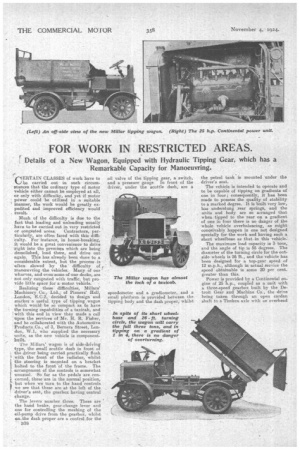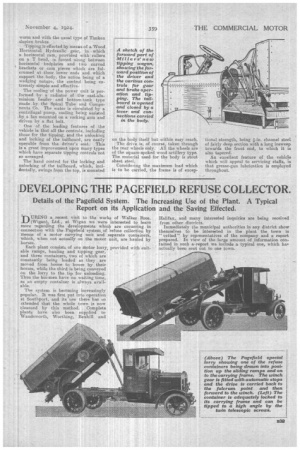FOR WORK IN RESTRICTED AREAS.
Page 22

Page 23

If you've noticed an error in this article please click here to report it so we can fix it.
r Details of a New Wagon, Equipped with Hydraulic Tipping Gear, which has a Remarkable Capacity for Manoeuvring.
riERTAIN CLASSES of Work have to 1...) be carried out in such circumstances that the ordinary type of motor vehicle either cannot be employed at all, or only with difficulty, and yet if motor power could be Utilized in a suitable
' manner, the work would be greatly expedited and improved efficienOy would result.
Much of the difficulty is due to the fact that loading and unloading usually have to be carried out in very restricted
or congested areas. Contractors, particularly, are often faced with this difficulty. For instance, in house-breaking, it would be a great convenience to drive right into the premises which are being demolished, load there, and drive out again. This has already been done to a considerable extent, bot the process is often slowed by the difficulty of manceuvring the vehicles. Many of our wharves, and even-some of our docks, are rot only congested with traffic; but pro vide little space for a motor vehicle. • Realizing these difficulties, Millers' Machinery Co.Ltd., of Pinners' Hall, London, Kai, decided to design and market a usef ul type of tipping wagon -which would he so compact as to have the turning capabilities of a taxicab, and with this end in view they made a call upon the services of Mr. H. R. Fisher, and he collaborated with the Automotive HProducts_Co., of 3, Berner s Street, London' W.1, who supplied the necessary 'units, as the new vehicle is component, built. The Millars' wagon is of side-driving :type, the small scuttle dash in front of the driver being carried practically flush .with the front of the radiator, whilst the steering is mounted on a bracket bolted to the front of the frame. The
L. arrangement of the controls is somewhat unusual. So far as the pedals are concorned, these are in the normal position,
I,but when we turn to the hand controls r we see that these are at the left of the driver's seat, the gearbox having central change.
The levers number three. These are the hand brake, gear-change lever and one for controlling the meshing of the • oil-pump drive from the gearbox, whilst on.the dash proper are acontrol for the B38, the petrol tank is mounted under the driver's seat.
The vehicle is intended to operate and to be capable of tipping on gradients of one in four ; consequently, it has been made to possess the quality of stability to a marked degree. It is built very low, has underslung rear springs, and the units and body are so arranged that when tipped to the rear on a gradient of one in four there is no danger of the whole vehicle overbalancing, as might conceivably happen in one not designed specially for the work and having such a short wheelbase as that in this vehicle.
The maximum load capacity is 3 tons, and the angle of tip is 55 degrees, The diameter of the turning circle for the out. side wheels is 26 ft., and the vehicle has been designed for a top-gear speed of 12 m.p.h., although in actual service the speed obtainable is some 20 per cent. greater than this.
Power is provided by a Continental engine of 25 hp., coupled as a unit with a three-speed gearbox built by the Detroit Gear and Machine Co., the drive being taken through an open cardan shaft to a Timken axle with an overhead
worm and with the usual type of Timken .duplex brakes.
Tipping is effected by memas of a Wood Horizontal Hydraulic gear, in which a horizontal ram, provided with rollers on a T head, is forced -along between horizontal bedplates and two curved brackets or cam pieces which are fulcrumed at their lower ends and which support the body, the action being of a wedging nature, the control being extremely simple and effective.
The cooling of the power unit is performed by a radiator of the cast-aluminium header and bottom-tank type made by the Spiral Tube and Components Co. The water is circulated by a centrifugal pump, cooling being assisted by a fan mounted on a rocking arm and driven by a flat belt, ' One of the leading features of the vehicle is that all the controls, including those for the tipping, and the unlocking and locking of the tailboard, are easily operable from the driver's seat. This is a great improvement upon many types which have separate tipping controls not so arranged.
The hand control for the locking and unlocking of the tailboard, which, incidentally, swings from the top, is mounted on the body itself but within easy reach. The drive is, of course, taken through the rear wheels only. All the wheels are of the square-spoked wood artillery type: The material used for the body is stout sheet steel.
Considering the maximum load which is to be carried, the frame is of excep tional strength, being i-in. channel steel of fairly deep section with a long insweep tewaids the front end, to which it is also tapered.
An excellent feature of the vehicle which will appeal to servicing staffs, is that grease-gun lubrication is employed throughout.
































